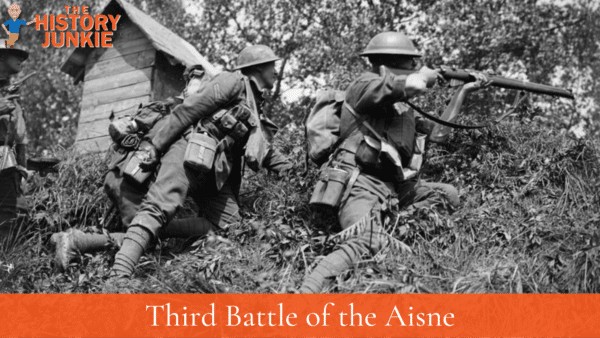The first two battles of the Aisne were fought by Allied forces, mostly French, against the German army in France, but the Third Battle of Aisne, from May 27 - June 6, 1918, was the last big German attempt to win World War 1 before the U.S. Army came to France, and it came after the Lys Offensive in Flanders.

Jump to:
Prelude
The target of the offensive was the Chemin des Dames Ridge, which the Germans had held since they pulled back from the Marne in September 1914 until the French kicked them out, with a lot of losses, during the Nivelle Offensive, also called the Second Battle of the Aisne, in April 1917.
Erich Ludendorff, who was under Paul von Hindenburg in the German Third Supreme Command but really ran the war for Germany, wanted to take back the Chemin des Dames Ridge from the French with a big surprise attack.
He hoped that the French would move forces from Flanders to the Aisne, and then he could attack again in the north, where he thought he could win the war.
At the time of the offensive, the front line of the Chemin des Dames was held by four divisions of the British IX Corps, who were sent from Flanders in early May to rest.
General Duchene, who led the French Sixth Army, was in charge of defending that area, and Lieutenant-General Sir Alexander Hamilton Gordon, who led the IX Corps, had to do what Duchene said.
So when Duchene decided to send the British divisions to the front line, Hamilton Gordon, who did not want to see his tired men in more danger, had to send his men forward.
He also suggested to Duchene that they should have a defense in depth in case of an attack. Duchene did not agree and wanted to put troops in front-line trenches.
The Battle
The attack started early on May 27 with a very heavy artillery fire of 4,000 guns across a 40 km front against four divisions of IX Corps.
Because there were a lot of British troops in front-line trenches, many were killed or wounded by the fire; the IX Corps was almost destroyed.
The fire was also followed by a gas attack to stop defensive gun crews, and then 17 divisions of German infantry, under Crown Prince Wilhelm, moved through a 25-mile gap in the Allied line.
The Allied forces were completely surprised and could not stop the German troops, who moved fast like they did at the start of the war.
Between Soissons and Reims, the Germans broke through eight more Allied divisions, four British and four French, and got to the Aisne in less than six hours.
By the end of the first day, they had taken over 9 miles of land and got to the River Vesle. By May 30, they had captured 50,000 Allied soldiers and 800 guns and got within 56 miles of Paris by June 3.
Conclusion
It looked like Germany might win again. But like before, they had problems with supplies and reserves and tired troops and also strong Allied counter-attacks that stopped their advance at the Marne. By June 6, they could not go any further.
The French lost a lot of men: 98,000; their British allies lost 29,000. General Duchene was fired by Petain, and people in Paris were very worried.
Petain’s own job was also in danger, and he had to follow what Ferdinand Foch said as he was now Allied Supreme Commander.
